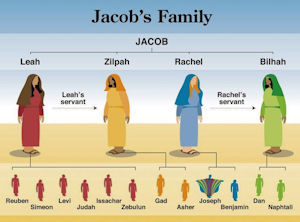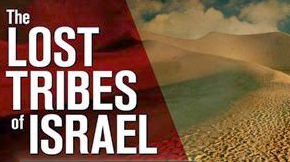Most Christians have heard of the Lost Tribes of Israel, but many have no idea of why they were lost or where any possible descendants may live today. It was not really any secret during New Testament days, for Jesus knew where they were and indicated that fact, but one must examine the Bible closely to figure it out. We sometimes read over things printed in God’s holy book without seeing the facts right in front of us.
And to completely understand Bible prophecy and God’s divine plan, we must be able to identify modern day Israel and I’m not speaking about that small state on the shore of the Mediterranean Sea founded after World War II in 1948. But, of course, in the Bible when speaking about Israel, it is about the people and not a specific geographic territory.
Two thousand years before Christ, God promised the first Hebrew patriarch, Abraham, the earth would one day be filled with his offspring and he kept that promise, as you will see. Abraham’s promised seed actually led to Jesus Christ, and also to the blessing of a whole world of peoples. This is what God said.
 “I will indeed bless you, and I will make your offspring as numerous as the stars of heaven and as the sand that is on the seashore. And your offspring shall possess the gate of their enemies, and by your offspring shall all the nations of the earth gain blessing for themselves, because you have obeyed my voice” (Genesis 22:17-18, NRSV).1
“I will indeed bless you, and I will make your offspring as numerous as the stars of heaven and as the sand that is on the seashore. And your offspring shall possess the gate of their enemies, and by your offspring shall all the nations of the earth gain blessing for themselves, because you have obeyed my voice” (Genesis 22:17-18, NRSV).1
Jacob, the grandson of Abraham, is considered another of the patriarchs in all three Abrahamic religions — Judaism, Christianity, and Islam. His story begins in the Book of Genesis, when he was one of the twin sons born to Isaac and Rebecca (Genesis 25:24-26). Later in life, God changed Jacob’s name to Israel (Genesis 32:27-28), and it is from him that the Twelve Tribes (clans) of Israel descended.
There were many times when someone’s name was changed in Bible times: because of a new relationship with God, to align a person to a new loyalty, status, change of nationality or religion, etc. An interesting article on this subject is “Why did some ancient people get their name changed?” It is listed at the end of this discourse in References & Notes.2
Jacob (Israel) had thirteen children, twelve sons and one daughter3 and all were from his wives Leah and Rachael or their maidservants (Bilhah and Zilpah). Although Jacob had children by these four women, his favorite spouse was Rachel and her firstborn was Joseph, who was born when he was about 74 years old.
These were his children: sons Judah, Reuben, Gad, Asher, Naphtali, Dan, Simeon, Levi, Isaachar, Zebulun, Joseph, Benjamin, and daughter Dinah. Only the men make up the twelve tribes of Israel, therefore there is no tribe of Dinah. And one son, Dan, became alienated from the land because of sin and was compared to the snake of Eden (Genesis 49:16-17). This tribe lost its original allotment of land through its military activities.
 Examining the Book of Revelation, we find a list of the twelve tribes at the end of this age (Revelation 7:4-8). The name of Dan is missing, and may “allude to Dan’s introducing the idolatry which caused the nation’s fall (Judges 18:30-31). Many think that it is a veiled reference to the Antichrist’s springing from Dan, and that this is why this tribe goes unmentioned in Revelation . . .”4
Examining the Book of Revelation, we find a list of the twelve tribes at the end of this age (Revelation 7:4-8). The name of Dan is missing, and may “allude to Dan’s introducing the idolatry which caused the nation’s fall (Judges 18:30-31). Many think that it is a veiled reference to the Antichrist’s springing from Dan, and that this is why this tribe goes unmentioned in Revelation . . .”4
But in place of Dan the name of Mannaseh is added. Mannaseh is the name of one of the two sons of Joseph. His other son, Ephriam, also plays a part in this puzzle as we will discover. Both sons were later adopted by Joseph’s father, Jacob.
So, in the last book of the Bible, the tribes of Israel are listed as: (1) Judah, (2) Reuben, (3) Gad, (4) Asher, (5) Naphtali, (6) Mannasseh, (7) Simeon, (8) Levi, (9) Isaachar, (10) Zebulun, (11) Joseph, (12) Benjamin.
So how did some tribes become lost?
Here is an overview of how the tribes of Israel got divided. Hundreds of years after leaving the slavery in Egypt, and after King Solomon died, “the Israelites divided their kingdom into two parts. The north became Israel with 10 tribes. The other two tribes in the south were called Judah.”5
Then Assyria conquered that northern kingdom of 10 tribes in 722 BC. Many of the Israelites were captured, but some fled or were deported to other areas and some emigrated down to Judah (2 Kings 17:5-6 and 1 Chronicles 5:26). Captives were taken to areas east and further north. Those fleeing captivity went into Egypt and some followed trade routes eastward into the Orient.6 Over time, they assimilated into various other societies and this dispersal of those Israelites became known as the Lost Tribes of Israel.
These lost tribes are a great concern for the Jews of today. Their return and gathering is an essential part of bringing about the end of days for them. According to some Jewish literature, the lost tribes were hidden beyond a mythical river in order to hide and separate them from humankind.7
And they believe that an ‘ingathering of the exiles’ is predicted by Ezekiel’s symbolic merger of two sticks (Ezekiel 37:15-28). “Ezekiel was to told to join the two sticks together, so that they would become one stick in his hand.”8
Many Christians have a different idea about this oracle. The prophesy mentioned in Ezekiel 37 concerned the two sticks (two kingdoms) becoming the complete House of Israel, and the House of Judah, and was fulfilled and brought together into the hand of Jesus upon his death with the ratification of the New Covenant through his blood.9
Jesus Knew Where the Lost Tribes Were
In the New Testament, speaking to his disciples, Jesus sent them out with these instructions, “Go nowhere among the Gentiles, and enter no town of the Samaritans, but go rather to the lost sheep of the house of Israel. As you go, proclaim the good news, ‘The kingdom of heaven has come near’,” (Matthew 10:5b-7).
 The message Jesus gave to his disciples was that their mission was specifically not to go to the Gentiles or to the Samaritans, but only to the lost people of Israel. This was because this first invitation was for God’s covenant people. The whole nation of Israel needed to accept Jesus as the King who had finally arrived. If the Israelites did so, then God would bless them (Genesis 12:3; Isaiah 60:3).10
The message Jesus gave to his disciples was that their mission was specifically not to go to the Gentiles or to the Samaritans, but only to the lost people of Israel. This was because this first invitation was for God’s covenant people. The whole nation of Israel needed to accept Jesus as the King who had finally arrived. If the Israelites did so, then God would bless them (Genesis 12:3; Isaiah 60:3).10
Jesus wanted the people of Israel to be the first to know that their Messiah had appeared; they were given the first opportunity to accept him. And to our Lord, the people of Israel were not just those in the local area, but those assimilated into societies at some distance away. Jesus and his disciples knew where the Lost Tribes of Israel resided at that time.
As a side note, although the lost sheep of Israel were to come first, Jesus did have compassion for others, as was proven with the granting of a Gentile woman’s request (Matthew 15:21-28). To fully understand this compassion, see the article “Did Jesus really call that Canaanite woman a dog?” It is listed in References & Notes.11
The world population was still rather small when our Lord walked on earth, and most of the lost tribes were likely still in the Africa-Europe-Asia areas. There has been much speculation (and some evidence) of Jesus’ travels during his ‘missing years’ so, it is reasonable that he knew and met many of them in his travels.
And later, too, the magnitude of the miracle at Pentecost underscores the very list of nations from which the lost tribes emigrated. That amazing event places emphasis on the real meaning of the supernatural account and many believe it demonstrated the reversal of the language confusion that affected the people in Babel (Genesis 11:1-9).12
When the day of Pentecost had come, they were all together in one place. And suddenly from heaven there came a sound like the rush of a violent wind, and it filled the entire house where they were sitting. Divided tongues, as of fire, appeared among them, and a tongue rested on each of them. All of them were filled with the Holy Spirit and began to speak in other languages, as the Spirit gave them ability.
Now there were devout Jews from every nation under heaven living in Jerusalem. And at this sound the crowd gathered and was bewildered, because each one heard them speaking in the native language of each. Amazed and astonished, they asked, “Are not all these who are speaking Galileans?” (Acts 2:1-7).
 These are the nations/regions represented by the people at this special event and plainly stated in the Bible (Acts 2:9-11): Parthians, Medes, Elamites, Cretans, Arabs, and from Mesopotamia, Judea, Cappadocia, Pontus, Asia, Phrygia, Pamphylia, Egypt, Libya, Cyrene, Rome.
These are the nations/regions represented by the people at this special event and plainly stated in the Bible (Acts 2:9-11): Parthians, Medes, Elamites, Cretans, Arabs, and from Mesopotamia, Judea, Cappadocia, Pontus, Asia, Phrygia, Pamphylia, Egypt, Libya, Cyrene, Rome.
These Jews of the ‘diaspora’ were in Jerusalem for a pilgrimage feast and were befuddled to hear Jews from Galilee speaking in the various languages of the peoples surrounding the Mediterranean Sea. They were hearing in their own real language, not an ecstatic utterance some call ‘speaking in tongues’.13
And Peter, at that time, addresses the crowd and speaks. Included were these words at the end of his message, “Therefore let the entire house of Israel know with certainty that God has made him both Lord and Messiah, this Jesus whom you crucified” (Acts 2:36). His words were specifically to the scattered Jews of the House of Israel, affirming that they had crucified their Lord and Messiah.14
Conclusion
During the two millennia since Pentecost, the Lost Tribes of Israel have grown and expanded outward to fill our earth. There are many theories about where the peoples of each of the ten clans ended up and you will find the debate continues today. There isn’t enough time in this article to dig into that detailed and complicated subject, but I’ll present an overview of one possible theory. It is an interesting subject and, with a bit of study, you can learn all the details and draw your own conclusions.
One suggestion for the predominant modern locations (but not all) of the tribes are: South Africa (Asher), Middle East (Judah, Levi, Simeon), Norway (Benjamin), Finland (Isaachar), Germany (Gad), Sweden (Naphthali), France (Rueben), Holland (Zebulon). Many believe that the sons of Joseph, Manessah and Ephraim (brothers), are considered each a half-tribe of Israel). They represent the United Kingdom (Great Britain) and the United States of America.
Any way one wishes to align the tribes with the world’s real estate, the point is that they are scattered all over the earth. Today, we are all part of those tribes. The Apostle Paul refers to a spiritual Israel, rather than dividing people politically or racially. He calls the body of Christian believers the “Israel of God” (Galatians 6:16). We are considered spiritual Israelites and are part of the promise made to Abraham. We are members of the offspring numbered as the sand on the seashore or the stars in heaven. We are the seed of Abraham (Galatians 3:7); we are the children of God (1 John 3:2).
My song selection for this study is one I used once before, but it fits this article perfectly. It is “We are the Sands, We are the Stars” featuring gospel baritone Todd Suttles. Selected lyrics are below and the music video is listed in References & Notes.15
 You took an old man walkin’ by the sea
You took an old man walkin’ by the sea
Waves and sand as far as he could see
“Now count the grains of sand, that stretch across the land
Trust Me now, so shall your seed be”
When evening fell You showed another sight
The wide black velvet canopy of night
“Now number all the stars, as countless as they are
Your children shall outnumber all these lights”
We are the stars, we are the sand
We are the promise that You made to Abraham
![]()
Copyright © 2022, Dr. Ray Hermann
OutlawBibleStudent.org
→ Leave comments at the end, after ‘References & Notes’.
Your email address will NOT be published. You can view our basic rules for comments by clicking “The Fine Print” on the top menu bar.
References & Notes
- All scripture quoted is from The Holy Bible: New Revised Standard Version, (Nashville: Thomas Nelson Publishers, 1989). Used with permission.
- Hermann, Ray, “Why did some ancient people get their name changed—and what is that about a white stone and new name for us?” (The Outlaw Bible Student, 11 June 2019), https://outlawbiblestudent.org/why-did-some-ancient-people-get-their-name-changed-and-what-is-that-about-a-white-stone-and-new-name-for-us/
- NOTE: There is debate about how many daughters Jacob had. In the Bible, one is mentioned by name, Dinah (Genesis 30:22), but there is another biblical mention of possibly more at Genesis 37:35: “All his sons and all his daughters sought to comfort him; but he refused to be comforted….” Also see Genesis 46:7.
- MacDonald, William, Believer’s Bible Commentary: Old and New Testaments, (Ed.) Arthur Farstad, (Nashville: Thomas Nelson, 1995), p. 81.
- “Who Are The “Lost Tribes of Israel”?” (Jewish Voice, retrieved 5 May 2022), https://www.jewishvoice.org/learn/who-are-lost-tribes-israel
- Ibid.
- “What Happened to the Lost Tribes of Israel?” (The Israel Bible, 12 November 2021), https://theisraelbible.com/what-happened-to-the-lost-tribes-of-israel/
- Ibid.
- Ognibene, Kellie, “Ezekiel’s Two-Sticks Gathered into One”, (A Pearl in the Vineyard, 24 March 2020), https://apearlinthevineyard.com/ezekiels-two-sticks-gathered-into-one/
- Walvoord John F. and Zuck, Roy B., The Bible Knowledge Commentary: An Exposition of the Scriptures, (Wheaton, IL: Victor Books, 1985), vol. 2, pp. 41-42.
- Hermann, Ray, “Did Jesus really call that Canaanite woman a dog?” (The Outlaw Bible Student, OBS, 20 January 2019, https://outlawbiblestudent.org/did-jesus-really-call-that-canaanite-woman-a-dog/
- Mays, James Luther, (Ed.), Harper’s Bible Commentary, (San Francisco: Harper & Row, 1988), pp. 1080-1082.
- Toussaint, Stanley D., in The Bible Knowledge Commentary, Walvoord and Zuck, (see above), vol. 2, p. 357.
- Sills, David M., in CSB Study Bible: Notes, (Eds.) Edwin Blum, et al., (Nashville TN: Holman Bible Publishers, 2017), p. 1721.
- “We Are The Sands, We Are The Stars”, Artist: Gaither Vocal Band featuring Todd Stuttles; Writers: Gloria Gaither, Reba Rambo-McGuire and Dony McGuire; Album/DVD: We Have This Moment; Label: Gaither Music Group, (Spring House Music, Inc., 2017, BMI), used under ‘fair use copyright’ for teaching under Section 107 of United States Copyright Act of 1976 – MUSIC VIDEO: https://youtu.be/G8Bs2o-3D-M


You say: “Although Jacob had children by these four women, his favorite spouse was Rachel and her firstborn was Joseph, who was born when he was about 74 years old. It is the line of Joseph from which Jesus came.”
Both parents of Jesus, Mary and Joseph, came from the tribe of Judah, not the tribe of Joseph. (See genealogy in the Gospels of Matthew and Luke) Where do you then get that from that Jesus is from the line of Joseph?
You are correct, of course. It took me a little time and examination of my original research notes to understand how this error surfaced in the article.
That sentence (It is the line of Joseph from which Jesus came) originally said, “Why was it not the line of Joseph from which Jesus came?” What was to follow was an answer to that question. The explanation was deleted before publishing, because it didn’t add any important information to the article. Unfortunately, the sentence in question was not deleted and grammar/syntax correction turned it into a statement, instead of a question. I have made the correction.
Anyway, since you are the first to notice this error, you deserved not only thanks for pointing it out, but the reason why it occurred in the first place.